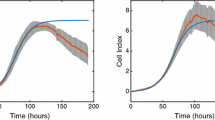Abstract
Mathematical models describing drug resistance are briefly reviewed. One model which describes the molecular function of the P-glycoprotein pump in multidrug resistant (MDR) cell lines has been developed and is presented in detail. The pump is modeled as an energy dependent facilitated diffusion process. A partial differential equation linked to a pair of ordinary differential equations forms the core of the model. To describe MDR reversal, the model is extended to add an inhibitor. Equations for competitive, one-site noncompetitive, and two-site noncompetitive inhibition are derived. Numerical simulations have been run to describe P-glycoprotein dynamics both in the presence and absence of these kinds of inhibition. These results are briefly reviewed. The character of the pump and its response to inhibition are discussed within the context of the models. All discussions, descriptions, and conclusions are presented in nonmathematical terms. The paper is aimed at a scientifically sophisticated but mathematically innocent audience.
Similar content being viewed by others
References
Birkhead BG, Gregory WM, Slevin ML and Harvey VJ (1986) Evaluating and designing cancer chemotherapy treatment using mathematical models. Eur J Cancer Clin Oncol 22: 3–8.
Coldman AJ and Goldie JH (1983) A model for the resistance of tumor cells to cancer chemotherapeutic agents. Math Biosci 65: 291–307.
Coldman AJ, Goldie JH and Ng V (1985) The effects of cellular differentiation on the development of permanent drug resistance. Math Biosci 74: 177–198.
Croop JM, Gros P and Housman DE (1988) Genetics of multidrug resistance. J Clin Invest 81: 1303–1309.
Curt GA, Clendeninn NJ and Chabner BA (1984) Drug resistance in cancer. Cancer Treat Rep 68: 87–99.
Day RS (1986) Treatment sequencing, asymmetry, and uncertainty: Protocol strategies for combination chemotherapy. Cancer Res 46: 3876–3885.
Demant EJF, Sehested M and Jensen PB (1990) A model for the computer simulation of P-glycoprotein and transmembrane pH mediated anthracycline transport in multidrug-resistant tumor cells. Biochim Biophys Acta 1055: 117–125.
Duc HN and Nickolls PM (1987) Multicompartment models of cancer chemotherapy incorporating resistant cell populations. J Pharmacokin Biopharm 2: 145–177.
Goldie JH and Coldman AJ (1979) A mathematical model for relating the drug sensitivity of tumors to their spontaneous mutation rate. Cancer Treat Rep 63: 1727–1733.
Goldie JH and Coldman AJ (1984) The genetic origin of drug resistance in neoplasms: Implications for systemic therapy. Cancer Treat Rep 67: 923–931.
Goldie JH, Coldman AJ and Gudauskas GA (1982) Rationale for the use of alternating non-cross-resistant chemotherapy. Cancer Treat Rep 66: 439–449.
Gottesman M and Pastan I (1988) Resistance to multiple chemotherapeutic agents in human cancer cells. Tr Pharmacol Sci 9: 54–58.
Gregory WM, Birkhead BG and Souhami RL (1988) A mathematical model of drug resistance applied to treatment for small-cell lung cancer. J Clin Oncol 6: 457–461.
Harris AL (1984) Drug resistance to cancer chemotherapy. Drugs Today 20: 657–663.
Hokanson JA, Brown BW, Thompson JR, Jansson B and Drewinko B (1986) Mathematical model for human myeloma relating growth kinetics and drug resistance. Cell Tissue Kinet 19: 1–10.
Horio M, Pastan I, Gottesman M and Handler J (1990) Transepithelial transport of vinblastine by kidney-derived cell lines. Application of a new kinetic model to estimate In situ Km of the pump. Biochim Biophys Acta 1027: 116–122.
Inaba M, Kobayashi H, Sakurai Y and Johnson RK (1979) Active efflux of daunorubicin and adriamycin in sensitive and resistant sublines of P388 leukemia. Cancer Res 42: 4730–4733.
Joshi RR (1985) On control of the function of the sodiumpotassium pump in malignant cells. Bull Math Biol 47: 551–564.
Juliano RL and Ling V (1976) Cell surface P-glycoprotein modulating drug permeability in Chinese hamster ovary cell mutants. Biochim Biophys Acta 455: 152–162.
Kartner N, Riordan JR and Ling V (1983) Cell surface P-glycoprotein associated with multidrug resistance in mammalian cell lines. Science 221: 1285–1288.
Ling V and Thompson LH (1974) Reduced permeability in CHO cells as a mechanism of resistance to colchicine. J Cell Physiol 83: 103–116.
Marx JL (1986) Drug resistance of cancer cells probed. Science 234: 818–820.
Michelson S and Slate D (1989) Emergence of the drug-resistant phenotype in tumor subpopulations: A hybrid model. JNCI 81: 1392–1401.
Michelson S and Slate DL (1992) A mathematical model of the multi-drug resistant P-glycoprotein pump. Bull Math Biol 54: 1023–1038.
Michelson S and Slate DL (1993) A mathematical model for the inhibition of the multidrug resistance-associated P-glycoprotein pump. Bull Math Biol, in press.
Moscow JA and Cowan KH (1988) Multidrug resistance. JNCI 80: 14–20.
Pastan I and Gottesman M (1987) Multiple drug resistance in human cancer. New Engl J Med 316: 1388–1393.
Schimke RT (1984) Gene amplification, drug resistance, and cancer. Cancer Res 44: 1735–1742.
Slate DL and Michelson S (1991) Drug resistance reversal strategies: A comparison of experimental data with model predictions. JNCI 83: 1574–1580.
Spoelstra EC, Westerhoff HV, Dekker H and Lankelma J (1992) Kinetics of daunorubicin transport by P-glycoprotein of intact cancer cells. Eur J Biochem 207: 567–579.
Tsuruo T, Iida H, Tsukagoshi S and Sakurai Y (1982) Increased accumulation of vincristine and adriamycin in drug-resistant P388 tumor cells following incubation with calcium antagonists and calmodulin inhibitors. Cancer Res 42: 4730–4733.
Warr JR and Atkinson GF (1988) Genetic aspects of resistance to anticancer drugs. Physiol Rev 66: 1–26.
Author information
Authors and Affiliations
Rights and permissions
About this article
Cite this article
Michelson, S. Mathematical models for multidrug resistance and its reversal. Cytotechnology 12, 315–324 (1993). https://doi.org/10.1007/BF00744670
Issue Date:
DOI: https://doi.org/10.1007/BF00744670




